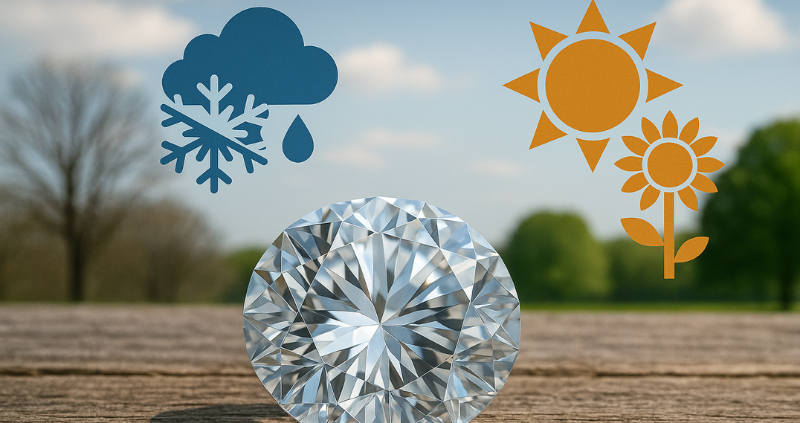How Weather and Seasons Affect Diamond Buying Behaviour

It’s easy to assume that diamond sales are driven purely by romance, budget, or trends. But dig a little deeper, and you’ll find that seasonal timing and even local weather play a big part in how consumers behave and how smart sellers position their inventory.
Let's explore how the calendar and climate influence buyer psychology, spending patterns, and sales spikes and how retailers and traders can ride those waves.
1. Seasonal Events = Predictable Sales Spikes
Let’s start with the obvious: certain seasons bring guaranteed demand.
Spring (March–April):
- New launches, exhibitions, and marketing campaigns start fresh
- Tax refunds (in countries like the U.S.) lead to higher discretionary spending
Engagement season Part 2 for buyers who skipped the winter Summer (May–July):
- Wedding season means sales in bridal sets, couple rings, and minimalist designs
- Travel jewellery is popular — lighter, more versatile pieces for honeymoons or vacations
Retailers often see a dip in heavy-duty investment buying Autumn (Sept–Oct):
- Strong pre-festive sales in India (Diwali, Karva Chauth, Navratri)
- Big sales push in the Middle East during Eid
Consumers begin making bigger jewellery investments ahead of major holidays Winter (Nov–Feb):
- Engagements spike during holidays (Christmas, New Year, Valentine's Day)
- Shoppers spend more due to holiday gifting budgets
- High-end pieces and custom designs move faster
- Wedding season
Insight: Knowing these rhythms allows you to adjust marketing, inventory, and pricing strategies throughout the year.
2. Weather Impacts Buyer Sentiment & Store Footfall
You’d be surprised how much weather affects diamond sales, especially in physical retail environments.
- Rainy weather tends to lower footfall in showrooms — online platforms often see a spike instead.
- Extreme heat may keep buyers indoors, delaying non-essential luxury purchases.
- Cool, dry weather (especially post-monsoon or during festive winter) typically increases physical visits to jewellery stores.
Pro Tip: Track regional weather data and plan campaigns accordingly — even flash discounts during low-footfall days can drive conversion online.
3. Online vs. Offline: Seasonal Traffic Shift
Digital platforms also follow seasonal draw backs and flows:
- Mobile traffic increases during long weekends and holidays when people are away from desktops.
- Gift guides and wishlist tools perform best during winter and festival seasons.
- High-intent traffic (buyers who are ready to spend) surges during November to February and pre-wedding seasons.
This means your digital listings, social media ads, and promotional banners should be tailored not just to product categories but also to what time of year it is.
4. Seasonal Trends in Styles and Colours
Just like fashion, diamond preferences shift with the seasons.
- Spring/Summer: Lighter styles, pastel accents, coloured stones (like fancy yellows, light pinks), and minimalist designs gain popularity.
- Autumn/Winter: Bolder cuts, classic solitaires, vintage-inspired settings, and deeper hues (ruby, emerald accents) are more in demand.
Match your inventory display and recommendations to seasonal aesthetic trends to stay on top of buyer moods.
5. Psychological Triggers: Timing Matters
Seasons not only impact spending ability but also emotional motivations:
- Festive months = emotional buying (gifting, self-love, family sentiment)
- Engagement season = high emotional investment, making buyers more detail-conscious
- End of financial year can trigger strategic purchases for wealth storage or tax planning
Understanding what drives your buyers at different points in the year can help you craft more compelling offers, better upselling strategies, and well-timed outreach.
Conclusion: Time Your Sparkle Right
Seasonality isn’t just a retail buzzword, it's a real, measurable force in diamond buying behavior. From festival-driven surges to climate-related footfall dips, every diamond business — whether wholesale or B2C can benefit from aligning its strategy with the seasons.
By planning ahead, adjusting your promotions, and reading the mood of your buyers, you can turn natural cycles into powerful sales momentum.

